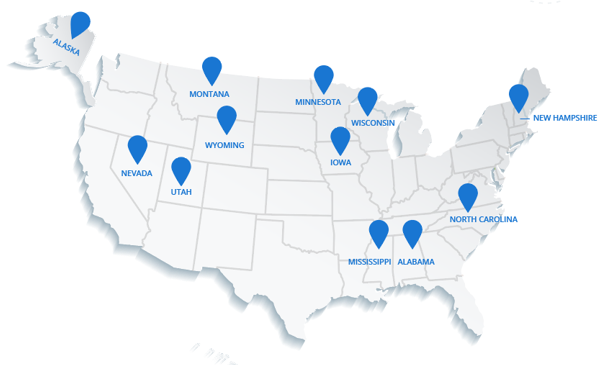Why is Clinician Burnout on the Rise: Statistics, Causes, and Cure
Burnout is a widespread problem reaching concerning levels among health care professionals, with more than 50% of physicians and one-third as many as 80% of nurses reporting burnout symptoms. With the nonstop influx of patients and the emotional toll of the pandemic, clinicians seem to be burning out earlier in their careers than ever before. Clinician burnout in 2022 is difficult to face head- but it's an important consideration so that you can stay in the profession you worked so hard to join.
Burnout is a condition resulting from acute workplace stress with challenges effectively managed in 3 segments:
(a) feelings of energy exhaustion,
(b) increased mental disturbance from one's job, and
(c) reduced professional efficiency
The National Academy of Medicine (NAM) action collaborative on clinician well-being and resilience has prioritized exploring ways to enhance baseline understanding of clinician well-being and promote multidisciplinary solutions to burnout.
Current scenario
Physicians and other healthcare workers were subjected to an increased workload during the COVID-19 crisis, leaving them exposed to significant physical and psychological distress. Therefore, a survey was conducted that aimed to
(i) assess the situation of burnout and levels of job satisfaction among physicians in the USA and
(ii) find out physicians' opinions, experiences, and perceptions during the pandemic crisis.
According to the findings of a USA poll:
- 80% of healthcare workers report being somewhat or very satisfied with their current job
- 73% agree with the statement, I love working in healthcare
- 52% report feeling burned out
- 23% said they might leave the field in the near future
According to Yahoo! Finance article, Demand for registered nurses will continue to grow by 5% in the next five years. As shortages persist due to resignations and retirement, employers will need to not only recruit 1.1 million new nurses by 2026 but retain their existing staff. Nurses continue to be affected by effects of the pandemic and they were experiencing burnout, according to TriangleNewsHub.com article.
Challenges
Physicians occupy some of the patient healthcare positions that experience the highest rates of burnout. 50% of all physicians experience burnout. Those working in intensive care and neurology are the most affected, with almost half of their colleagues identified as suffering from the problem. Close behind, family physicians, gynecologists, and internists reported burnout rates of nearly 50 percent
As for other medical fields, the picture is far from rosy. It found that the group seemingly least affected by burnout was plastic surgeons, who reported 23 percent burnout. If one-fourth of any group is identified as burned out, there is a cause for concern. The picture isn't much better for dermatologists. These specialists are the second least affected group, reporting that one-third of their population is burned out.
Burnout also affects nurses. A full 40 percent described themselves as experiencing emotional exhaustion. Nurses also show the highest rates of depression of any worker in the United States.
Clinician Burnout Contributing Factors
- Gender- Women and men experience burnout to different degrees. According to studies, 48 percent of female doctors report burnout, compared to 38 percent of their male counterparts.
- Age- While it may seem intuitive to think that younger physicians experience more stress and burnout as they try to establish a medical practice, early career physicians report lower rates of burnout. The rates increase from about 35 percent for physicians in the 28-34 age range to 50 percent for physicians in the 45-54 age group. After that peak, rates drop to about 41 percent for late-career physicians aged 55-69.
- Employment- While it may seem intuitive to think that younger physicians experience more stress and burnout as they try to establish a medical practice, early career physicians report lower rates of burnout. The rates increase from about 35 percent for physicians in the 28-34 age range to 50 percent for physicians in the 45-54 age group. After that peak, rates drop to about 41 percent for late-career physicians ages 55-69.
- Understaffing: Over 80% of nurses believe understaffing is a key cause of burnout.
- Emotional exhaustion: About 76% of nurses have emotional exhaustion that plays a role in their burnout.
- High workload demands: Even before the pandemic, the shortage of nurses caused nurses to take on more patients each shift. More than three-quarters of nurses have high workload demands contributing to burnout.
- Workplace morale and culture: High-pressure workplaces can lower morale, lower productivity, and create a culture of division and criticism. Feelings of disappointment, distraction, and fear are often associated with low morale.
Key Factors contributing to Burnout during Covid-19
- Younger age
- A decline in social support systems in the workplace and in the community
- Low preparedness to cope with the outbreak of COVID-19 among family members and colleagues
- The lower level of specialized COVID19 training
- The increased perceived threat from exposure to or illness from COVID-19
- Hospital workplace with insufficient material and human resources
- High-risk work environment
- Longer working hours in quarantine areas
- Increased workload
Compare the above to pre-pandemic factors, which were:
- Overwhelming workloads
- No breaks during shifts
- Lack of adequate sleep
- Excessively long shifts
Curing Burnout
Burnout is a corrosive aspect of the healthcare industry that needs to be addressed and prevented. Fortunately, there are ways to address the problem before it further disrupts healthcare systems. One of the key areas is communication. Physician satisfaction in the workplace has been shown to increase significantly when communication improves and becomes clearer.
Another way to help prevent or cure burnout in healthcare is to help make personal health and wellness a priority for physicians. When hard-working healthcare workers slow down and take some vacation time, incorporate or improve effective exercise and nutrition practices, and even talk to counselors, the symptoms of burnout begin to subside.
Since burnout rates are so high, perhaps the most important way to prevent this problem from growing further is to start identifying the problem. There are diagnostic tools that healthcare administrators can use to identify burnout in their workplaces. Once the problem is identified, management can begin to look for ways to improve communication, support self-service practices, and streamline workflows. When we are able to recognize burnout and see it as a systemic rather than a personal problem, it is possible to make progress in combating it.
Final Thoughts
Burnout is a serious matter in any industry, and it's even worse when it affects healthcare workers. This phenomenon arises from emotional exhaustion, depersonalization, and the feeling that one's achievements, skills, or overall competence are lacking in the workplace. Any of these factors can lead to poor decision-making, inattention, or other performance problems. If the stress level in your current role is unmanageable, prioritize other matters and move on. At DirectShifts, we help doctors find exciting opportunities that allow for a better work-life balance. Explore now!
August 23, 2022




Comments